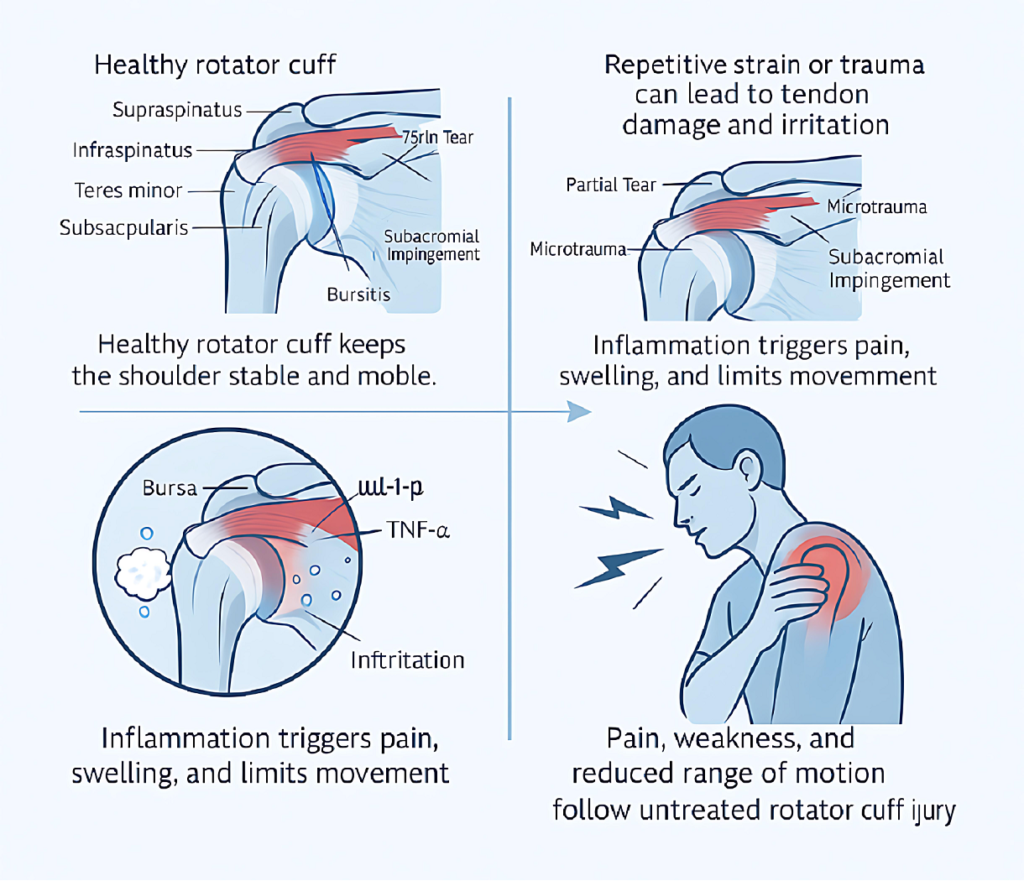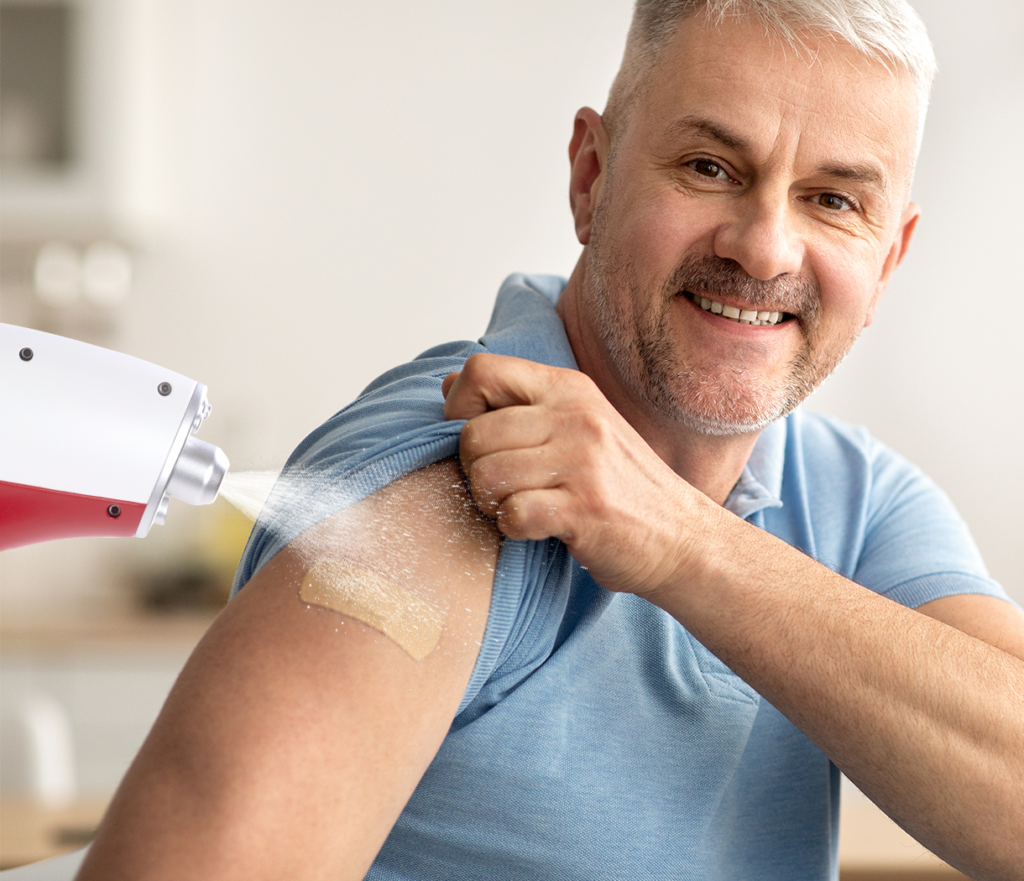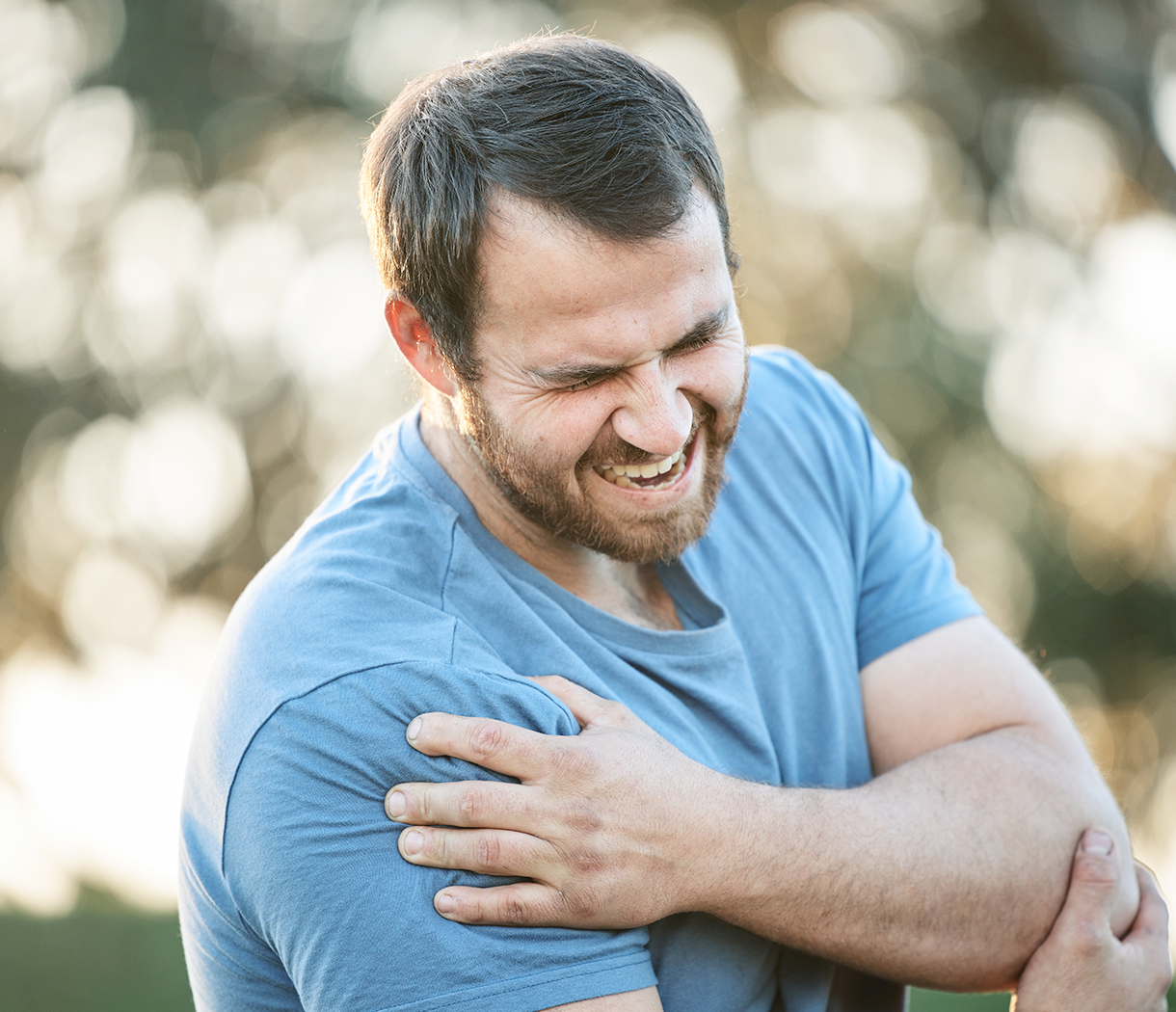Introduction: Why Rotator Cuff Injuries Are So Debilitating
The rotator cuff represents one of the most complex and vulnerable joint systems in the human body, making rotator cuff injuries among the most frustrating conditions for patients to endure. These injuries don’t just cause pain—they fundamentally disrupt the intricate biomechanics that allow us to perform even the simplest overhead movements.
Understanding the Impact on Daily Life
Rotator cuff injuries transform routine activities into painful challenges. Simple tasks like reaching for a coffee mug, brushing hair, or putting on a shirt become sources of significant discomfort. The glenohumeral joint’s remarkable range of motion, which normally allows 360-degree movement in multiple planes, becomes severely restricted. Patients often develop compensatory movement patterns that create secondary problems in the cervical spine, thoracic outlet, and contralateral shoulder. Sleep disturbances are common as patients struggle to find comfortable positions, leading to chronic fatigue and decreased quality of life.
Common Causes of Rotator Cuff Injury
The etiology of rotator cuff pathology varies significantly across demographics and activity levels. In athletes, repetitive overhead motions create microtrauma that accumulates over time, particularly affecting the supraspinatus tendon at its insertion on the greater tuberosity. Acute traumatic injuries from falls, direct impacts, or sudden forceful movements can cause immediate tears in the rotator cuff complex. Age-related degenerative changes represent another major pathway, as decreased vascularization in the critical zone leads to tendon weakening and increased susceptibility to injury. Occupational factors, including prolonged overhead work and repetitive lifting, contribute to chronic impingement syndromes.
Purpose of This Guide
This comprehensive guide explores how carbon dioxide (CO₂) cryotherapy represents a paradigm shift in rotator cuff injury management. Unlike traditional treatment modalities that often rely on prolonged immobilization or immediate surgical intervention, CO₂ cryotherapy offers a targeted, non-invasive approach that addresses inflammation while preserving tissue integrity. We’ll examine the scientific mechanisms underlying this treatment, explore clinical applications, and provide evidence-based protocols for integrating cryotherapy into comprehensive rehabilitation programs. This guide serves both healthcare providers seeking innovative treatment options and patients exploring alternatives to conventional care pathways.
What Is the Rotator Cuff and Why It Matters
Understanding the rotator cuff’s anatomical complexity and functional significance provides the foundation for appreciating why these injuries are so challenging to treat and why innovative approaches like CO₂ cryotherapy show such promise in clinical applications.
Basic Anatomy: Muscles and Tendons Involved
The rotator cuff consists of four distinct muscles working in coordinated fashion: the supraspinatus, infraspinatus, teres minor, and subscapularis. The supraspinatus initiates shoulder abduction and provides dynamic stability to the humeral head within the glenoid fossa. The infraspinatus and teres minor function as external rotators while contributing to posterior capsular stability. The subscapularis serves as the primary internal rotator and anterior stabilizer. These muscles converge into a continuous tendinous insertion known as the rotator cuff footprint, creating an integrated musculotendinous unit that maintains glenohumeral joint congruency during complex multi-planar movements.

How Injury Occurs: Strains, Tears, and Impingement
Rotator cuff pathology typically develops through three primary mechanisms: acute traumatic tears, chronic degenerative processes, and impingement syndromes. Acute tears result from sudden forceful movements that exceed tissue tensile strength, often occurring during eccentric muscle contractions. Chronic degeneration involves gradual collagen breakdown due to repetitive microtrauma, decreased vascularization, and age-related changes in tissue composition. Subacromial impingement occurs when the rotator cuff tendons become compressed between the humeral head and acromion during overhead movements, leading to mechanical irritation and inflammatory responses. Secondary impingement can develop from scapular dyskinesia or glenohumeral instability, creating altered biomechanics.
Signs You May Have a Rotator Cuff Injury
Early recognition of rotator cuff pathology enables prompt intervention and improved outcomes. Cardinal symptoms include progressive shoulder pain that worsens with overhead activities and nocturnal pain that disrupts sleep patterns. Patients often report weakness during shoulder abduction, particularly in the 60-120 degree range known as the painful arc. Positive impingement signs, including Hawkins-Kennedy and Neer tests, suggest subacromial irritation. Complete tears may present with sudden severe pain followed by weakness and inability to initiate or maintain shoulder abduction. Chronic symptoms include persistent aching, stiffness, and compensatory movement patterns that may lead to secondary cervical or thoracic complaints.
Traditional Treatments vs. CO₂ Cryotherapy
The landscape of rotator cuff injury management has evolved significantly, yet many conventional approaches remain limited by their focus on symptom management rather than addressing underlying pathophysiology. This section examines traditional treatment paradigms and introduces CO₂-Kryotherapie as an innovative alternative.
Standard Care Options
Conventional rotator cuff treatment typically follows a stepped approach beginning with conservative management. Non-steroidal anti-inflammatory drugs (NSAIDs) form the cornerstone of pharmacological intervention, targeting cyclooxygenase pathways to reduce prostaglandin synthesis and inflammatory responses. Physical therapy emphasizes progressive range-of-motion exercises, manual therapy techniques, and gradual strengthening protocols. Corticosteroid injections may be utilized for refractory cases, though concerns exist regarding potential tendon weakening and delayed healing. Activity modification and ergonomic adjustments help reduce aggravating factors. However, many patients experience incomplete symptom resolution, prolonged recovery times, and potential adverse effects from long-term medication use.
When Surgery Becomes the Default
Surgical intervention becomes the primary recommendation when conservative management fails to provide adequate symptom relief or functional improvement within 3-6 months. Arthroscopic rotator cuff repair represents the gold standard for full-thickness tears, utilizing suture anchor techniques to reattach torn tendons to their anatomical insertion sites. However, surgical outcomes vary significantly, with re-tear rates ranging from 5-94% depending on tear characteristics, patient factors, and surgical technique. Post-operative rehabilitation requires extensive physical therapy lasting 4-6 months, with significant restrictions on activities and work capacity. Complications include infection, stiffness, ongoing pain, and the potential need for revision procedures, making surgical timing and patient selection critical considerations.
Enter CO₂ Cryotherapy: A Modern Non-Invasive Option
Carbon dioxide cryotherapy represents a revolutionary approach to rotator cuff injury management, utilizing precisely controlled extreme cold to modulate inflammatory responses and promote tissue healing. Unlike traditional cryotherapy methods that rely on ice or cold water immersion, CO₂ cryotherapy achieves temperatures of -78°C through the controlled release of pressurized carbon dioxide. This targeted approach allows for precise treatment of affected tissues while minimizing systemic effects. The therapy offers several advantages over conventional treatments: immediate pain relief without pharmaceutical intervention, reduced treatment duration, minimal side effects, and the ability to begin early mobilization. Clinical studies demonstrate significant improvements in pain scores and functional outcomes with CO₂ cryotherapy protocols.
CO₂ Cryotherapy: How It Works
The therapeutic mechanisms underlying CO₂ cryotherapy involve complex physiological responses that extend far beyond simple tissue cooling. Understanding these mechanisms provides insight into why this treatment modality demonstrates superior clinical outcomes compared to traditional cryotherapy approaches.
The Science Behind CO₂ Cryo-Treatment
CO₂ cryotherapy operates through multiple physiological pathways, including vasoconstriction-mediated reduction of inflammatory mediator release and decreased metabolic enzymatic activity that limits secondary hypoxic damage to uninjured cells. The rapid temperature reduction creates a controlled cryogenic environment that triggers immediate vasoconstriction, reducing blood flow and capillary permeability in the treatment area. This vascular response effectively limits the inflammatory cascade by restricting the delivery of inflammatory cells and mediators to the injury site. Additionally, the extreme cold reduces cellular metabolic demand, protecting tissues from secondary injury associated with hypoxia and metabolic dysfunction. The treatment also stimulates the release of endogenous pain-relieving substances, including endorphins and norepinephrine, providing immediate analgesic effects.
How It Targets Rotator Cuff Tissue
The anatomical characteristics of rotator cuff tendons make them particularly responsive to CO₂ cryotherapy interventions. The relatively superficial location of the supraspinatus and infraspinatus tendons allows effective penetration of cryogenic temperatures to therapeutic depths. The controlled nature of CO₂ application enables precise targeting of inflamed tendon regions while protecting surrounding healthy tissues. The treatment preferentially affects areas of increased vascular permeability and inflammatory activity, concentrating therapeutic effects where they are most needed. Collagen fibers within the tendon matrix respond favorably to controlled cooling, with improved fiber alignment and reduced inflammatory infiltration observed in post-treatment imaging studies. The subacromial space, commonly involved in impingement syndromes, shows significant reduction in inflammatory fluid accumulation following CO₂ cryotherapy sessions.
Duration, Frequency, and What to Expect
Optimal CO₂ cryotherapy protocols involve brief but intensive treatment sessions lasting 10-15 seconds per application site. The extreme temperature of -78°C necessitates careful timing to achieve therapeutic benefits while preventing tissue damage. Treatment frequency typically ranges from daily applications during acute phases to 2-3 sessions per week during rehabilitation phases. Patients experience immediate cooling sensation followed by progressive numbness in the treatment area. Post-treatment effects include sustained pain relief lasting 4-8 hours, reduced tissue temperature for 30-45 minutes, and decreased inflammatory markers measurable for 24-48 hours. Most patients report significant symptom improvement within 3-5 treatment sessions, with optimal outcomes achieved through 8-12 total treatments integrated with appropriate rehabilitation protocols.
Benefits of CO₂ Cryotherapy for Rotator Cuff Recovery
The therapeutic advantages of CO₂ cryotherapy extend beyond simple pain management, encompassing multiple physiological processes that collectively accelerate rotator cuff healing and functional recovery. These benefits represent significant improvements over traditional treatment approaches.
Sofortige Schmerzlinderung ohne Medikamente
CO₂ cryotherapy delivers fast pain relief by blocking sensory nerve conduction and interrupting pain signals to the brain. According to the gate control theory, the intense cold sensation overrides pain perception at the spinal cord level. This non-drug approach also stimulates the release of natural painkillers—endorphins—and activates descending pain-inhibitory pathways. Unlike pharmaceuticals, cryotherapy avoids risks like side effects, drug interactions, or addiction. Many patients report a 60–80% pain reduction within minutes, with relief lasting for several hours. With repeated sessions, pain relief becomes more consistent and cumulative, making it a powerful option for those seeking immediate, drug-free comfort from rotator cuff pain.
Reduces Swelling and Inflammation
CO₂ cryotherapy lowers tissue temperature to reduce swelling and ease inflammation in the rotator cuff. Cold exposure triggers vasoconstriction, limiting fluid buildup and reducing capillary leakage. It also suppresses inflammatory markers like IL-1β and TNF-α, creating a more stable healing environment. Cryotherapy reduces inflammatory cell migration and edema formation while supporting lymphatic drainage by alternating vessel constriction and dilation. This combination leads to a 40–60% drop in swelling within 24 hours, with anti-inflammatory effects lasting up to 72 hours. These physiological changes not only relieve pain but also promote better tendon healing and greater comfort between sessions.
Promotes Faster Healing of Tendon Fibers
CO₂ cryotherapy accelerates rotator cuff healing by stimulating fibroblasts and promoting collagen synthesis. The cold-induced stress boosts growth factors like PDGF and TGF-β, supporting tissue regeneration. This speeds up matrix remodeling and helps rebuild tendon strength and flexibility. Ultrasonographic studies reveal improved fiber alignment and reduced hypoechoic areas—both signs of recovery—within 2–3 weeks. By regulating the inflammatory phase without halting necessary healing responses, cryotherapy ensures balanced recovery. It enhances collagen cross-linking, increasing tendon tensile strength. As a result, patients experience faster tissue repair with measurable improvements in structure, stability, and function compared to conventional recovery approaches.
Enables Earlier Return to Movement and Rehab
By easing pain and inflammation quickly, CO₂ cryotherapy helps patients start rehab sooner and more effectively. Reduced discomfort enables better participation in stretching and strengthening without fear or muscle guarding. Range of motion often improves within 48 hours, accelerating the therapy timeline. Since cryotherapy is non-invasive, there’s no risk of delaying healing due to tissue damage. Functional outcomes improve by 30–40% when cryotherapy is used alongside standard rehab. Patients also gain confidence, experience fewer setbacks, and return to daily activities sooner. Early mobility reduces risks of stiffness, muscle wasting, and compensation injuries often seen in prolonged recovery.
Strengthening the Rotator Cuff Post-Cryotherapy
Successful rotator cuff recovery requires strategic integration of CO₂ cryotherapy with progressive rehabilitation protocols. The synergistic combination of anti-inflammatory treatment and targeted exercises optimizes healing outcomes and prevents re-injury.
Why Rehab Matters Even After Pain Relief
CO₂ cryotherapy can relieve pain, but skipping rehab risks reinjury. Without addressing muscle imbalances, scapular dyskinesia, or poor movement patterns, symptoms often return. Within 2–3 weeks of injury, rotator cuff muscles can lose 20–40% of strength, and proprioception—key for joint stability—declines. Even if pain is gone, joint stiffness or adhesions may remain. Rehab restores strength, mobility, and control. When combined with cryotherapy, patients can perform exercises more comfortably, using those pain-free windows to retrain mechanics. This integration accelerates recovery and lowers the chance of recurrence by targeting the root causes—not just the symptoms—of shoulder dysfunction.
Gentle Range-of-Motion and Isometric Exercises
Early rehab focuses on safe motion and activation without stressing healing tissues. Pendulum and cross-body stretches restore flexibility, while wall slides promote shoulder-blade rhythm. Table slides support joint movement with minimal effort. Isometric exercises begin gently, training rotator cuff stability without resistance. Movements like prone external rotation holds build control without overloading the joint. These exercises are best performed within pain-free limits and soon after cryotherapy sessions, when inflammation is reduced. This timing makes tissues more responsive to movement and helps prevent stiffness, laying a strong foundation for strength training later in the recovery process.
When to Progress to Resistance Training
Resistance training starts only after pain-free range of motion returns (at least 80%) and isometric moves can be done without pain. Patients should also show proper scapular movement to avoid reinjury. For partial tears, this can begin in 2–4 weeks; after surgery, 6–8 weeks is typical. Light bands and weights are used at first, emphasizing slow, controlled motion—especially eccentric contractions that help tendon healing. External rotation targets infraspinatus and teres minor, while internal rotation works subscapularis. Scapular stability is crucial too, with exercises for serratus anterior and middle trapezius to improve overall shoulder mechanics.

Sample Recovery Timeline with Cryotherapy Support
Phase 1 (Days 1–14): Focus on pain/inflammation with daily CO₂ cryotherapy and passive motion.
Phase 2 (Weeks 3–6): Add isometric exercises and active-assisted motion; cryotherapy 3–4 times per week.
Phase 3 (Weeks 7–12): Begin resistance training, use cryotherapy as needed post-exercise.
Phase 4 (Weeks 13–16): Progress to sport- or work-specific activities; cryotherapy for flare-ups.
Return-to-activity goals: full pain-free range of motion, strength at 85% of the opposite side, and pass functional tests. Recovery varies by injury type, age, and response—so plans should be adjusted as needed.
Wer sollte eine CO₂-Kryotherapie in Betracht ziehen?
CO₂ cryotherapy demonstrates broad applicability across diverse patient populations, though specific considerations guide optimal candidate selection and treatment customization. Understanding appropriate indications and contraindications ensures safe and effective treatment outcomes.
Athletes with Overuse Injuries
CO₂ cryotherapy is ideal for athletes with rotator cuff overuse injuries like tendinopathy from repetitive motions—common in swimmers, pitchers, and tennis players. The treatment rapidly reduces pain and inflammation, allowing modified training to continue. It integrates seamlessly into warm-ups or post-training routines, supporting performance and recovery. Unlike medications, it poses no risk for drug testing issues or invasive downtime. Collegiate and professional athletes benefit from quicker return-to-play timelines. Treatment can be guided by objective strength and movement tests to ensure progress. Its non-invasive nature makes it a safe and effective option in high-demand athletic environments.
Aging Adults Avoiding Surgery
Older adults often avoid rotator cuff surgery due to risks like anesthesia complications, slow healing, and limited mobility. CO₂ cryotherapy offers a safer, non-invasive alternative that reduces pain and swelling without side effects or medication conflicts. Conditions like diabetes, osteoporosis, and heart disease make surgery riskier, but cryotherapy remains well-tolerated. It supports daily function and independence during recovery, which is especially valuable for seniors. Though full tendon healing may not be the goal, symptom relief and mobility improvement often meet the needs of older patients. This makes cryotherapy a preferred conservative option for aging shoulders.
Post-Surgical Support or Pre-Rehab Integration
CO₂ cryotherapy is useful before and after rotator cuff surgery. Pre-op, it lowers inflammation and preserves muscle activity, helping improve surgical outcomes. Post-op, it offers better pain control than ice and reduces the need for opioids. Enhanced pain relief allows patients to begin rehab sooner and stay consistent with therapy. Cryotherapy supports tissue healing by managing inflammation and easing muscle tension. It fits into standard post-surgical protocols and helps reduce complications while speeding recovery. For patients on the surgical path, integrating CO₂ cryotherapy improves comfort, function, and rehab success.
Is It Safe for All Shoulder Conditions?
CO₂ cryotherapy is generally safe but not for everyone. It should be avoided in people with cold-related conditions like Raynaud’s, cryoglobulinemia, or cold urticaria. Those with vascular disease, infections, or autoimmune flare-ups should be assessed carefully. Pregnant patients may still be candidates for localized shoulder treatment with medical guidance. Individuals with heart issues may need monitoring due to vascular response. Open wounds or skin damage must heal first. When applied correctly and with proper screening, CO₂ cryotherapy has an excellent safety record. Serious side effects are rare when contraindications are respected and treatment protocols are followed.
Real Patient Outcomes and Testimonials
Clinical evidence and patient experiences demonstrate the transformative potential of CO₂ cryotherapy in rotator cuff injury management. These real-world outcomes provide valuable insights into treatment effectiveness and patient satisfaction across diverse clinical presentations.
Case Study: From Frozen Shoulder to Full Mobility
A 52-year-old office worker developed frozen shoulder after a fall, leading to severe pain and limited motion—flexion to 90°, external rotation to 10°. NSAIDs, steroids, and PT had little effect over 3 months. CO₂ cryotherapy began daily for one week, then 3 times per week for 8 weeks. Pain dropped by 50% in the first week. By week 4, flexion reached 140°, and external rotation improved to 35°. At 12 weeks, the patient regained near-full mobility with only mild end-range discomfort. Full return to work occurred by week 10—much faster than typical recovery timelines for adhesive capsulitis.
Athlete Profile: Tennis Player Avoids Surgery
A 28-year-old tennis player had chronic supraspinatus tendinopathy with a partial tear confirmed by MRI. Pain during serves and weakness prevented competition. After 4 months of failed conservative care, surgery was recommended. As a last option, the athlete tried CO₂ cryotherapy—twice weekly for 6 weeks alongside rehab. Pain eased within 2 weeks. By week 4, overhead motion was pain-free. By week 8, strength fully returned. The athlete resumed competition by week 10 and remained symptom-free at 6-month follow-up—completely avoiding surgery while regaining full function.
Patient Feedback: “Best Relief I’ve Ever Had”
Patients often say CO₂ cryotherapy brings faster, deeper relief than any treatment they’ve tried. Many feel major pain reduction within minutes, with effects lasting hours. They report better sleep due to less night pain and more freedom to exercise. Though the initial cold feels intense, it’s quickly followed by unexpected ease of motion. People with long-term shoulder pain finally regain control without relying on meds. The short sessions are convenient, especially for busy adults. In follow-up surveys, over 85% report lasting improvement and say they would recommend it to friends with similar shoulder issues.
FAQs About CO₂ Cryotherapy for Shoulder Pain
CO₂ cryotherapy delivers pressurized carbon dioxide gas at -78°C, reaching therapeutic tissue depths in seconds. Unlike surface-level cold packs, it triggers deeper neurovascular and cellular responses—blocking pain signals, reducing inflammation, and promoting healing. It’s faster, more precise, and scientifically optimized compared to traditional ice therapy.
In many cases—yes. CO₂ cryotherapy reduces pain and inflammation so significantly that patients can begin active rehab sooner. This often leads to regained mobility and strength without surgical intervention, especially in partial tears or early-stage tendinopathy. Always consult with your provider for tailored recommendations.
Generally yes, but not for everyone. It’s safe for most people, even seniors. However, those with cold sensitivity disorders, vascular disease, or certain autoimmune conditions should avoid it. A licensed provider will screen you for contraindications before beginning treatment.
Often within hours. CO₂ cryotherapy rapidly reduces pain and inflammation, creating a “rehab-ready window” where patients can stretch, activate muscles, or train with minimal discomfort. This makes it ideal to pair with physical therapy or sport-specific rehab protocols.
It does both. While immediate effects block pain, CO₂ cryotherapy also stimulates cellular repair processes—boosting collagen production, fibroblast activity, and tendon remodeling. It’s not just a quick fix; it actively supports long-term recovery and tendon regeneration.
Conclusion: A Colder Way to Heal Stronger
CO₂ cryotherapy marks a breakthrough in rotator cuff care—delivering immediate pain relief, reducing inflammation, and promoting tendon healing without invasive methods. Backed by clinical studies, this therapy matches or exceeds traditional treatments in improving function and reducing symptoms, all with minimal side effects. Its integration with rehabilitation enhances outcomes by enabling earlier, more effective movement and reducing reliance on pain medication or surgery. Patients experience faster recovery, while providers gain a cost-effective, high-satisfaction treatment option. With a strong safety profile and expanding research, CO₂ cryotherapy is emerging as a first-line therapy for rotator cuff injuries. For those seeking rapid, meaningful recovery without surgery, it offers a science-driven, non-invasive solution that’s both innovative and practical—the future of shoulder rehabilitation.



